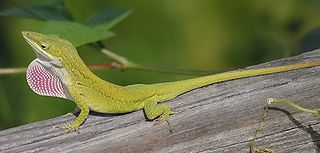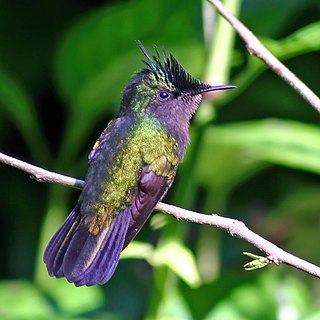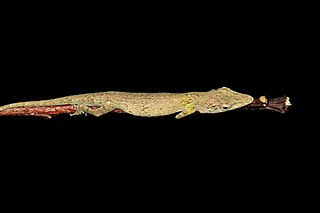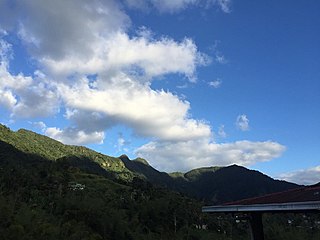Related Research Articles

In evolutionary biology, adaptive radiation is a process in which organisms diversify rapidly from an ancestral species into a multitude of new forms, particularly when a change in the environment makes new resources available, alters biotic interactions or opens new environmental niches. Starting with a single ancestor, this process results in the speciation and phenotypic adaptation of an array of species exhibiting different morphological and physiological traits. The prototypical example of adaptive radiation is finch speciation on the Galapagos, but examples are known from around the world.

Dactyloidae are a family of lizards commonly known as anoles and native to warmer parts of the Americas, ranging from southeastern United States to Paraguay. Instead of treating it as a family, some authorities prefer to treat it as a subfamily, Dactyloinae, of the family Iguanidae. In the past they were included in the family Polychrotidae together with Polychrus, but the latter genus is not closely related to the true anoles.

Anolis is a genus of anoles, iguanian lizards in the family Dactyloidae, native to the Americas. With more than 425 species, it represents the world's most species-rich amniote tetrapod genus, although many of these have been proposed to be moved to other genera, in which case only about 45 Anolis species remain. Previously, it was classified under the family Polychrotidae that contained all the anoles, as well as Polychrus, but recent studies place it in the Dactyloidae.

Anolis carolinensis or green anole is a tree-dwelling species of anole lizard native to the southeastern United States and introduced to islands in the Pacific and Caribbean. A small to medium-sized lizard, the green anole is a trunk-crown ecomorph and can change its color to several shades from brown to green.

The brown anole, also known commonly as the Cuban brown anole, or De la Sagra's anole, is a species of lizard in the family Dactyloidae. The species is native to Cuba and the Bahamas. It has been widely introduced elsewhere, via the importation and exportation of plants where the anole would lay eggs in the soil of the pots, and is now found in Florida and other regions of the United States including southern Georgia, Texas, Louisiana, Tennessee, Mississippi, Alabama, Hawaii, and Southern California. It has also been introduced to other Caribbean islands, Mexico, and Taiwan.

Midwestern State University is a public liberal arts university in Wichita Falls, Texas. In 2020 it had 5,141 undergraduate students. It is the state's only public institution focused on the liberal arts.

The knight anole is the largest species of anole in the Dactyloidae family. Other common names include Cuban knight anole or Cuban giant anole, highlighting its native country, but it has also been introduced to Florida. In its native Cuba, this large anole is called chupacocote.

The Malayan night heron, also known as Malaysian night heron and tiger bittern, is a medium-sized heron. It is distributed in southern and eastern Asia.

The Antillean crested hummingbird is a species of hummingbird in the family Trochilidae. Found across Anguilla, Antigua and Barbuda, Barbados, Dominica, Grenada, Guadeloupe, Martinique, Montserrat, north-east Puerto Rico, Saba, Saint-Barthélemy, Saint Kitts and Nevis, Saint Lucia, Saint Martin, Saint Vincent and the Grenadines, Sint Eustatius, the British Virgin Islands, the U.S. Virgin Islands, and the Lesser Antilles, while it has also been recorded as a vagrant in Florida, USA.

Anolis cristatellus is a small species of anole, belonging to the Dactyloidae family of reptiles. The species is native to Puerto Rico and the U.S. and British Virgin Islands, with introduced populations in locations around the Caribbean. The males of A. cristatellus are easily recognizable by the fin running down the top of the tail, which is known as a "caudal crest". The females also have this crest, but it is smaller than that of the males. The species is often quite common in many areas on Puerto Rico, where it can be seen during the day passing the time on the lower parts of tree trunks, or on fences and the walls of buildings in urban areas, sometimes venturing down onto the ground in order to lay eggs, have a snack, or do other cursorial activities. Like many anoles, this species displays the characteristic behaviour of doing push-ups as well as inflating a pizza-like flap of coloured skin on its throat, known as a dewlap, in order to show others how dominant it is, and thus attract mates or intimidate rivals.

Anolis allisoni, also known commonly as Allison's anole or Cuban blue anole is a species of lizard in the family Dactyloidae. The species is endemic to Cuba, the Bay Islands and Cayos Cochinos off the mainland of Honduras, and Half Moon Caye off the mainland of Belize. There is also a single doubtful record from Cozumel, Mexico. Recently, the species has been documented in southern Florida. This diurnal species is commonly seen on palm trunks, and it feeds on invertebrates. It is among the relatively few anole species in which females may lay their eggs together, forming a communal nest.

Anolis bartschi, also known commonly as the Pinar Del Rio cliff anole, western cliff anole, and the west Cuban anole, is a species of lizard in the family Dactyloidae. The species is endemic to Cuba.

The Puerto Rican twig anole or dwarf anole is a species of small, arboreal anole endemic to Puerto Rico and primarily inhabiting the Cordillera Central from the Sierra de Cayey range in the Southeast to the central-western ranges of Maricao. A mostly grey to olive-brown bodied lizard, A. occultus is the smallest of the Puerto Rican anoles with a snout to vent length of 34–42 mm. In comparison to other twig anoles, A. occultus is extremely cryptic through its unique sleeping behaviors and mottled pattern. Sleeping behavior including site selection minimizes the probability of predator encounter along with A. occultus' extensive list of antipredator behaviors.

Anolis oculatus, the Dominica anole, Dominican anole, eyed anole or zandoli, is a species of anole lizard. It is endemic to the Caribbean island of Dominica, where it is found in most environments. The species is found in a diverse range of color forms, which one herpetologist once classified as four subspecies, which most other scientists did not recognise because the forms gradually inter-grade with one another. Two later researchers have instead promoted the "ecotypes" concept, hypothesizing the color forms are maintained by the ecological conditions of the surrounding environment, despite being genetically indistinguishable. The morphology of some traits is subject to clinal variation, gradually changing from one side of the island to the other, or from sea level to the hilltops. The ground color ranges from pale tan or yellow to deep green or brown. It also has patterned markings that range from light-colored speckling to complex marbled patterns, and some populations also have large black-ringed "eye" spots on their flanks.

Anolis grahami, commonly known as the Jamaican turquoise anole and Graham's anole, is a species of lizard in the family Dactyloidae. The species is native to the island of Jamaica, and has also been introduced to the territory of Bermuda. It is one of many different species of anole lizards found in Jamaica. There are two recognized subspecies.

The ecomorph concept is a term first coined by Ernest Edward Williams in 1972 which he defined as a “species with the same structural habitat/niche, similar in morphology and behavior, but not necessarily close phyletically.” Williams first applied this definition to the Greater Antillean anoles upon observing their evolutionary radiation, although it has since been used widely elsewhere.

Anolis stratulus is a moderately-sized species of anole found in Puerto Rico, the United States Virgin Islands and the British Virgin Islands. It is a gray-colored lizard spotted with brown markings. It is arboreal, usually found positioned on tree bark on branches in the canopies of forest trees, where in some areas of Puerto Rico it can be incredibly abundant, with tens of thousands of the lizards being present per hectare.

Black Birders Week is a week-long series of online events to highlight black nature enthusiasts and to increase the visibility of black birders, who face unique challenges and dangers when they are engaged in outdoor activities. The event was created as a response to the Central Park birdwatching incident and police brutality against Black Americans. The inaugural event ran from May 31 to June 5, 2020. The week of events was organized by a group of STEM professionals and students known as the BlackAFinSTEM Collective.

Los Tres Picachos State Forest is one of the 20 forests that make up the public forest system of Puerto Rico. The forest is located in the Central Mountain Range or Cordillera Central, along the Los Tres Picachos mountain ridge, one of the island's highest mountains, named after the distinctive three peaks of the highest mountain in the forest. The state forest is located in the municipalities of Jayuya and Ciales.
References
- 1 2 Newberry, Andy (18 June 2020). "MSU Texas student achieves national attention with #BlackBirdersWeek campaign". MSU Texas News. Retrieved 2022-09-28.
- ↑ "New Science: Chelsea Connor". California Academy of Sciences. Retrieved 2022-09-28.
- 1 2 3 Kutz, Cat (4 June 2020). "#BlackBirdersWeek: Celebrating and Encouraging Diversity in Conservation". Smithsonian Magazine. Retrieved 2022-09-28.
- ↑ Howell, Bailey (6 January 2020). "SICB 2020: Invasive and Native Anoles Have Different Dietary Niches". Anole Annals. Retrieved 2022-09-28.
- 1 2 3 Richard-Craven, Maya (31 May 2022). "Meet Six Black Birders You'll Want to Follow on Instagram". Sierra Club. Retrieved 2022-09-28.
- 1 2 "#BlackBirdersWeek Seeks To Make The Great Outdoors Open To All". NPR . 4 June 2020. Retrieved 2022-09-28.
- ↑ Mallenbaum, Carly. "#BlackBirdersWeek, #BlackInNeuro: Black scientists, physicians are using hashtags to uplift". USA Today. Retrieved 2022-09-28.
- ↑ "Black Birders Week | BirdNote". www.birdnote.org. 2021-05-28. Retrieved 2022-09-28.